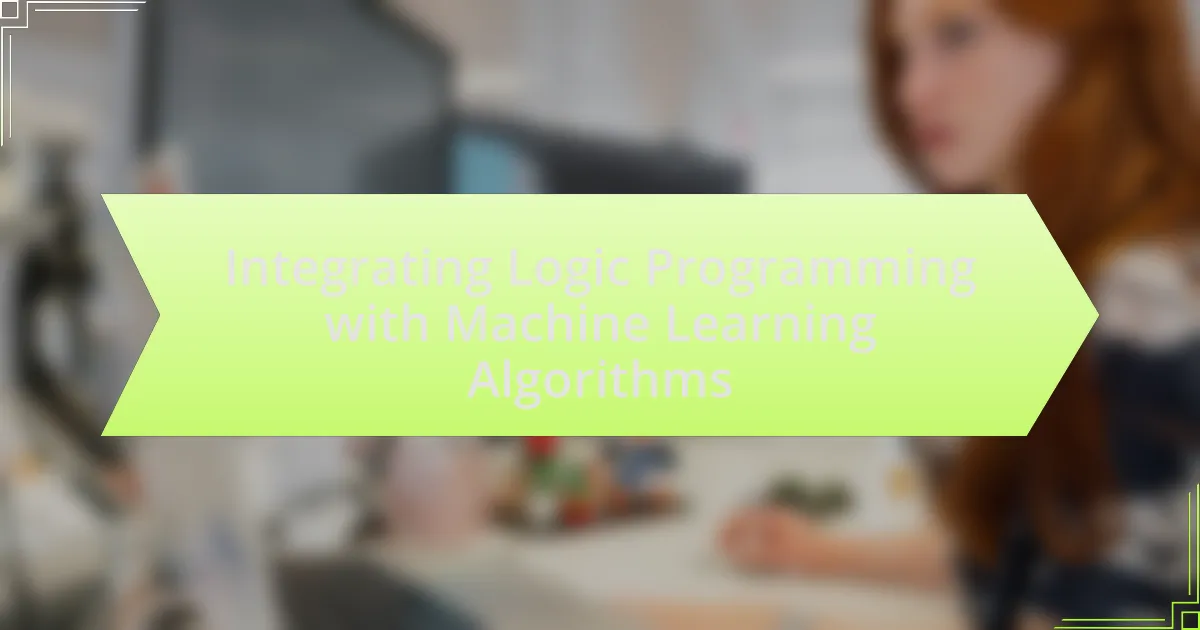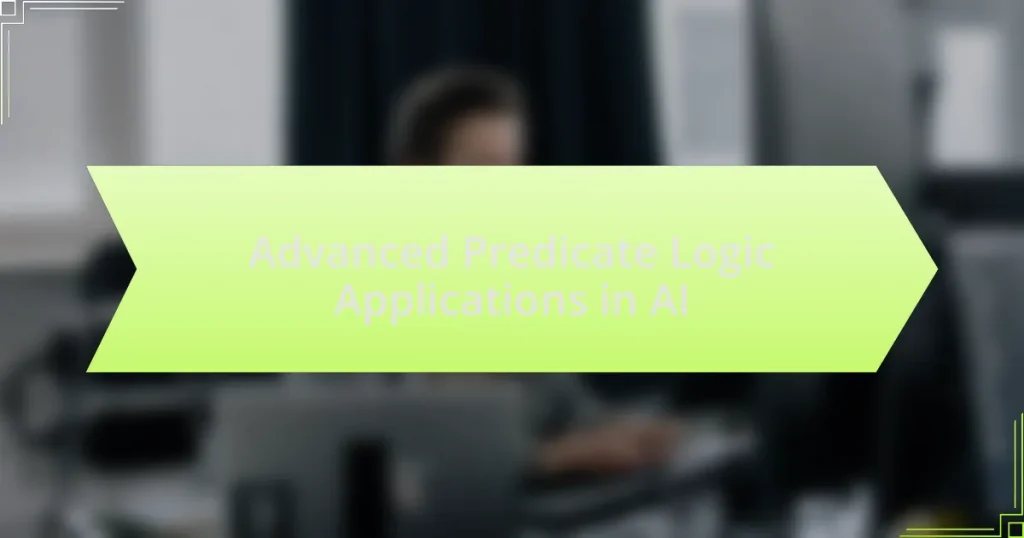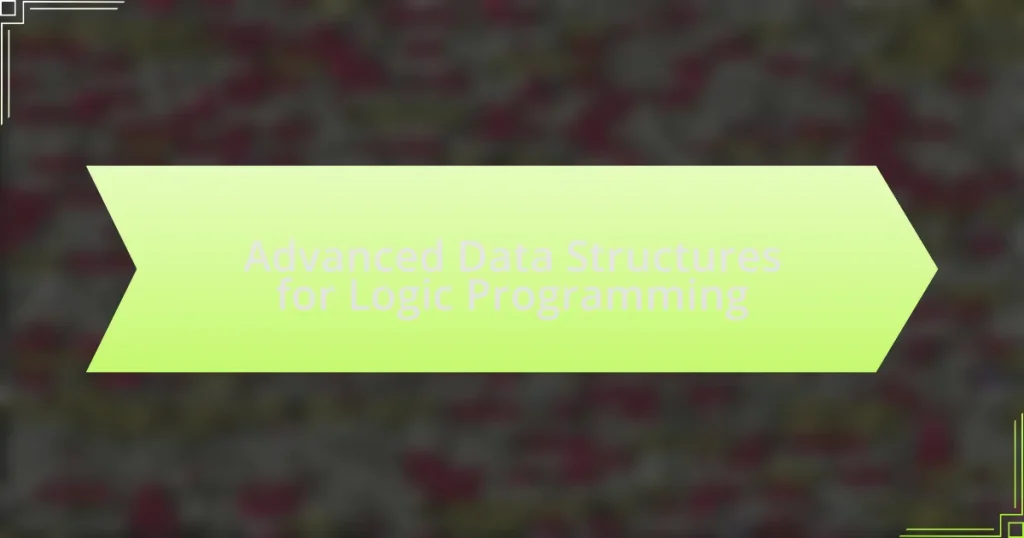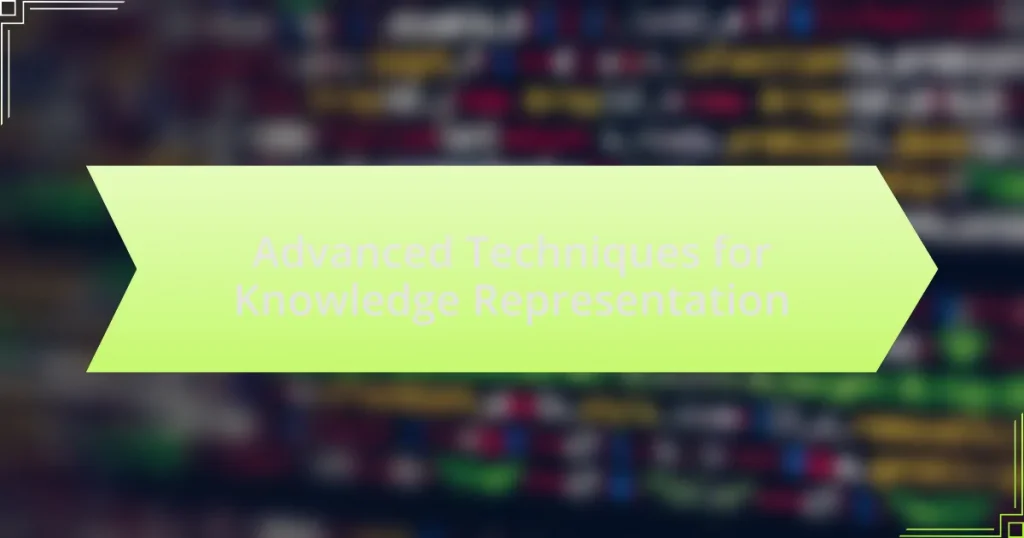Integrating Logic Programming with Machine Learning Algorithms combines the formal rules and relationships of logic programming with the data-driven predictive capabilities of machine learning. This integration enhances knowledge representation and reasoning in AI systems, leading to improved decision-making processes. Key concepts include the intersection of logical representations with learning algorithms, foundational principles of both fields, and methodologies such as Inductive Logic Programming and neuro-symbolic systems. The article also addresses the practical applications, challenges, and future trends in this integration, highlighting its significance in domains like natural language processing and automated reasoning.
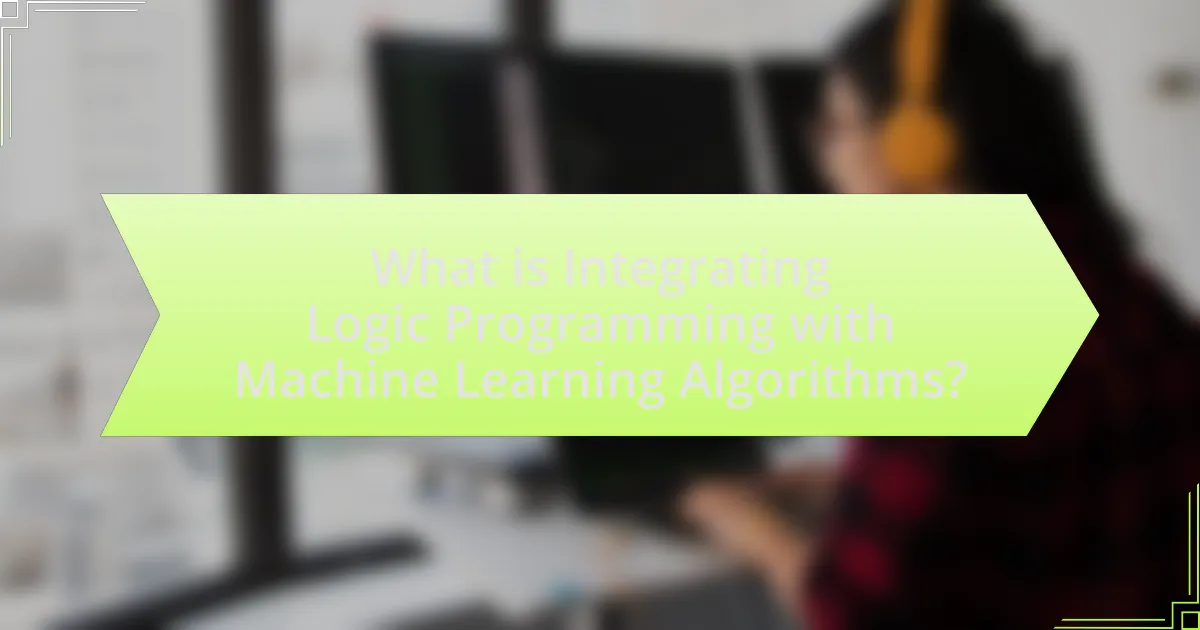
What is Integrating Logic Programming with Machine Learning Algorithms?
Integrating Logic Programming with Machine Learning Algorithms involves combining the declarative nature of logic programming, which focuses on formal rules and relationships, with the predictive capabilities of machine learning, which learns from data. This integration allows for the creation of systems that can reason about data while also adapting and improving their performance based on new information. For instance, research has shown that such integration can enhance knowledge representation and reasoning in AI systems, leading to more robust decision-making processes.
How do Logic Programming and Machine Learning intersect?
Logic programming and machine learning intersect primarily through the use of logical representations to enhance learning algorithms. Logic programming provides a formal framework for knowledge representation and reasoning, which can be utilized in machine learning to improve model interpretability and reasoning capabilities. For instance, systems like Inductive Logic Programming (ILP) combine logic programming with inductive learning techniques, allowing for the extraction of rules from data while maintaining logical consistency. This intersection enables the development of models that not only learn from data but also reason about it, as evidenced by applications in natural language processing and automated reasoning tasks.
What are the foundational principles of Logic Programming?
The foundational principles of Logic Programming include the use of formal logic as a programming paradigm, where programs are expressed in terms of relations and rules rather than explicit control flow. Logic Programming is based on the concepts of facts, rules, and queries, allowing for declarative problem-solving. The primary proof of its validity lies in its theoretical foundation, which is rooted in first-order predicate logic, enabling automated reasoning and inference through resolution and unification techniques. These principles facilitate the integration of Logic Programming with Machine Learning algorithms by providing a structured way to represent knowledge and infer new information from existing data.
What are the key concepts in Machine Learning?
The key concepts in Machine Learning include supervised learning, unsupervised learning, reinforcement learning, overfitting, underfitting, and feature selection. Supervised learning involves training a model on labeled data to make predictions, while unsupervised learning deals with finding patterns in unlabeled data. Reinforcement learning focuses on training agents to make decisions through trial and error in an environment. Overfitting occurs when a model learns noise in the training data, leading to poor generalization, whereas underfitting happens when a model is too simple to capture the underlying trend. Feature selection is the process of identifying the most relevant variables to improve model performance. These concepts are foundational in developing effective Machine Learning algorithms and applications.
Why is the integration of these two fields important?
The integration of logic programming with machine learning algorithms is important because it enhances the interpretability and reasoning capabilities of machine learning models. Logic programming provides a formal framework for representing knowledge and rules, which can improve decision-making processes in AI systems. For instance, combining these fields allows for the creation of models that not only learn from data but also apply logical reasoning to derive conclusions, leading to more robust and explainable AI solutions. This integration has been shown to improve performance in various applications, such as natural language processing and automated reasoning, where understanding the underlying logic is crucial for effective outcomes.
What advantages does this integration provide in problem-solving?
The integration of logic programming with machine learning algorithms enhances problem-solving by combining the strengths of both approaches, leading to more robust and interpretable solutions. Logic programming provides a structured framework for reasoning and knowledge representation, while machine learning offers the ability to learn from data and adapt to new information. This synergy allows for the development of systems that can reason about complex problems while also leveraging empirical data to improve accuracy. For instance, research has shown that integrating these methodologies can lead to better performance in tasks such as natural language processing and automated reasoning, where both logical inference and data-driven insights are crucial for effective problem-solving.
How does it enhance the capabilities of AI systems?
Integrating logic programming with machine learning algorithms enhances the capabilities of AI systems by enabling them to reason and learn from structured knowledge. This integration allows AI systems to utilize formal logic to represent complex relationships and rules, which improves their ability to make informed decisions based on both data and logical inference. For instance, research has shown that combining these approaches can lead to more robust models that can generalize better from limited data, as demonstrated in studies like “Combining Logic Programming and Machine Learning” by Alviano et al., which highlights improved performance in tasks requiring reasoning under uncertainty.
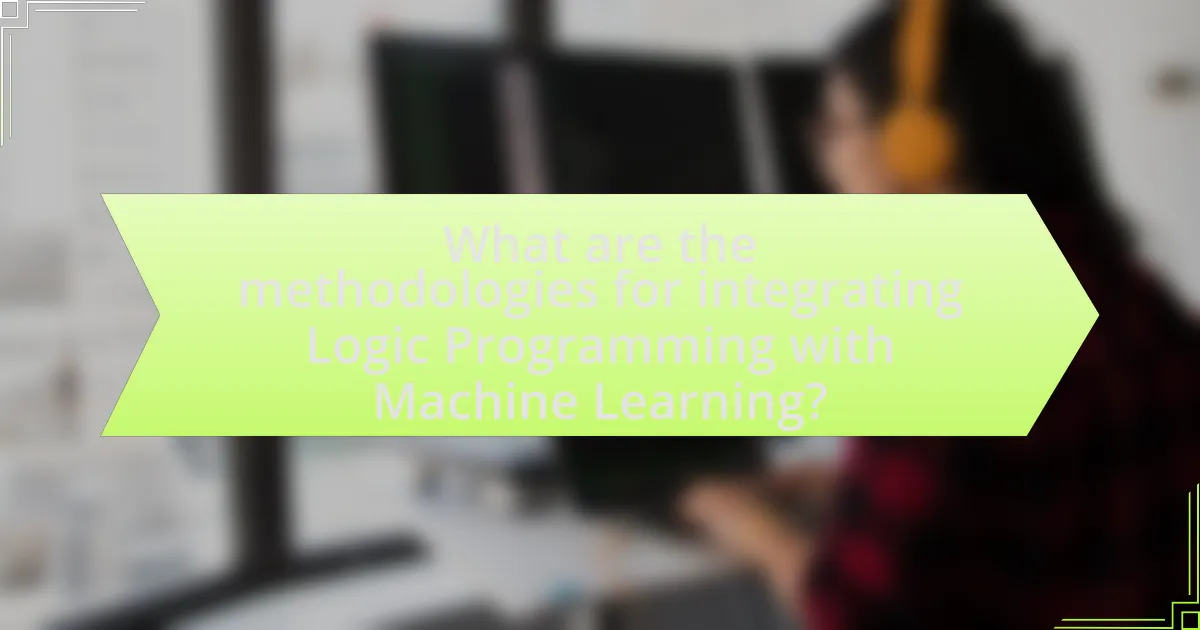
What are the methodologies for integrating Logic Programming with Machine Learning?
The methodologies for integrating Logic Programming with Machine Learning include Inductive Logic Programming (ILP), which combines logic programming with inductive reasoning to learn logical rules from examples. Another methodology is the use of Answer Set Programming (ASP) in conjunction with machine learning techniques to handle complex reasoning tasks. Additionally, integrating probabilistic logic programming allows for the incorporation of uncertainty in models, enhancing decision-making processes. These methodologies are supported by research such as “Inductive Logic Programming: Theory and Methods” by N. Lavrac and S. Dzeroski, which outlines the effectiveness of ILP in learning from structured data.
What approaches exist for combining these technologies?
Approaches for combining logic programming with machine learning algorithms include hybrid models, where logic-based rules are integrated with statistical learning techniques, and neuro-symbolic systems, which merge neural networks with symbolic reasoning. Hybrid models leverage the strengths of both paradigms, allowing for interpretable decision-making while utilizing data-driven insights. Neuro-symbolic systems, as demonstrated in research by Garcez et al. (2019) in “Neural-Symbolic Learning Systems: Foundations and Applications,” effectively combine the representational power of logic with the learning capabilities of neural networks, enabling complex reasoning tasks. These approaches facilitate enhanced performance in tasks requiring both logical reasoning and data-driven learning.
How does rule-based learning fit into this integration?
Rule-based learning fits into the integration of logic programming with machine learning algorithms by providing a structured framework for knowledge representation and decision-making. This approach allows for the encoding of domain-specific knowledge in the form of rules, which can be utilized by machine learning algorithms to enhance their interpretability and reasoning capabilities. For instance, rule-based systems can guide the learning process by constraining the search space, thereby improving efficiency and accuracy in model training. Research has shown that integrating rule-based learning with machine learning can lead to better generalization and performance, as evidenced by studies such as “Combining Logic Programming and Machine Learning” by De Raedt et al., which highlights the effectiveness of this integration in various applications.
What role do neural-symbolic systems play?
Neural-symbolic systems play a crucial role in integrating logic programming with machine learning algorithms by combining the strengths of both approaches to enhance reasoning and learning capabilities. These systems leverage neural networks for pattern recognition and data-driven learning while utilizing symbolic reasoning to handle complex logical relationships and knowledge representation. For instance, research has shown that neural-symbolic systems can improve interpretability and generalization in AI models, as evidenced by the work of Garcez et al. (2019) in “Neural-Symbolic Learning Systems: Foundations and Applications,” which highlights their effectiveness in tasks requiring both learning from data and reasoning with rules.
What challenges arise during integration?
Challenges during integration of logic programming with machine learning algorithms include compatibility issues, complexity in combining different paradigms, and difficulties in knowledge representation. Compatibility issues arise because logic programming and machine learning often utilize different data structures and methodologies, making seamless integration challenging. The complexity of combining the rule-based nature of logic programming with the statistical approaches of machine learning can lead to difficulties in achieving optimal performance. Additionally, knowledge representation poses a challenge, as logic programming requires explicit rules while machine learning often relies on implicit patterns learned from data, complicating the integration process.
How can the complexity of logic representation be managed?
The complexity of logic representation can be managed through abstraction and modularization techniques. Abstraction simplifies complex logic by focusing on high-level concepts while hiding lower-level details, making it easier to understand and manipulate. Modularization divides logic into smaller, manageable components or modules, allowing for independent development and testing. Research indicates that using these techniques can significantly reduce the cognitive load on developers and improve the maintainability of logic systems. For instance, in the context of integrating logic programming with machine learning algorithms, employing these strategies can streamline the interaction between the two paradigms, facilitating more efficient learning and reasoning processes.
What are the limitations of current integration techniques?
Current integration techniques between logic programming and machine learning algorithms face several limitations, including scalability, interpretability, and computational complexity. Scalability issues arise as the size of data increases, making it challenging for existing techniques to maintain performance. Interpretability is often compromised, as the complex models generated by machine learning can obscure the reasoning processes inherent in logic programming. Additionally, computational complexity can hinder the efficiency of integration, as combining the two paradigms may lead to increased resource demands and longer processing times. These limitations highlight the need for more robust methods that can effectively bridge the gap between logic programming and machine learning.

What are the practical applications of this integration?
The practical applications of integrating logic programming with machine learning algorithms include enhanced reasoning capabilities in AI systems, improved decision-making processes, and more efficient data handling. This integration allows for the development of systems that can reason about data and learn from it simultaneously, leading to applications in areas such as natural language processing, where understanding context and semantics is crucial. For instance, combining Prolog, a logic programming language, with machine learning techniques can improve the accuracy of language models by enabling them to apply logical rules to infer meaning from text. Additionally, in healthcare, this integration can facilitate better diagnostic systems by allowing algorithms to reason about patient data while learning from historical cases, thus improving predictive analytics.
In which domains is this integration most beneficial?
The integration of logic programming with machine learning algorithms is most beneficial in domains such as natural language processing, knowledge representation, and automated reasoning. In natural language processing, this integration enhances the ability to understand and generate human language by combining the structured reasoning capabilities of logic programming with the adaptive learning features of machine learning. In knowledge representation, it allows for more effective modeling of complex relationships and rules, facilitating better decision-making processes. Automated reasoning benefits from this integration by improving the efficiency and accuracy of inference processes, enabling systems to derive conclusions from a set of premises more effectively.
How is it applied in natural language processing?
Logic programming is applied in natural language processing (NLP) to enhance the understanding and generation of human language through structured reasoning. By integrating logic programming with machine learning algorithms, NLP systems can leverage formal rules and knowledge representation to improve tasks such as semantic parsing, information extraction, and dialogue systems. For instance, systems like Prolog can be used to define grammatical structures and infer relationships, allowing for more accurate interpretation of context and meaning in text. This approach has been validated in research, such as the work by Kwiatkowska et al. (2019) in “Logic Programming for Natural Language Processing,” which demonstrates how logic-based frameworks can effectively model linguistic phenomena and improve the performance of NLP applications.
What impact does it have on automated reasoning systems?
Integrating logic programming with machine learning algorithms enhances automated reasoning systems by improving their ability to handle uncertainty and complex reasoning tasks. This integration allows systems to leverage the strengths of both paradigms: the structured, rule-based approach of logic programming and the adaptive, data-driven capabilities of machine learning. For instance, research has shown that combining these methodologies can lead to more robust decision-making processes in systems like Prolog-based frameworks, which can incorporate learned knowledge from data to refine their reasoning capabilities. This synergy results in systems that are not only more efficient but also capable of reasoning in dynamic environments, as evidenced by advancements in applications such as natural language processing and automated theorem proving.
What best practices should be followed when integrating these technologies?
When integrating logic programming with machine learning algorithms, best practices include ensuring compatibility between the two technologies, maintaining clear data flow, and leveraging the strengths of each approach. Compatibility can be achieved by selecting logic programming languages that support machine learning frameworks, such as Prolog with TensorFlow. Clear data flow involves defining how data will be transformed and shared between logic rules and machine learning models, which enhances efficiency and reduces errors. Leveraging strengths means utilizing logic programming for rule-based reasoning and machine learning for pattern recognition, thus creating a hybrid system that maximizes performance. These practices are supported by successful implementations in various domains, such as natural language processing and automated reasoning, where the combination has led to improved accuracy and interpretability of results.
How can developers ensure effective collaboration between Logic Programming and Machine Learning?
Developers can ensure effective collaboration between Logic Programming and Machine Learning by creating hybrid systems that leverage the strengths of both paradigms. This involves integrating declarative reasoning from Logic Programming with the data-driven approaches of Machine Learning, allowing for enhanced interpretability and reasoning capabilities. For instance, using frameworks like Prolog for rule-based inference alongside Machine Learning models can facilitate better decision-making processes. Research has shown that such integrations can improve model accuracy and provide clearer explanations for predictions, as evidenced by studies demonstrating that combining symbolic reasoning with statistical learning leads to more robust AI systems.
What tools and frameworks facilitate this integration?
Tools and frameworks that facilitate the integration of logic programming with machine learning algorithms include Prolog, TensorFlow, and PyTorch. Prolog serves as a foundational logic programming language that allows for the representation of knowledge and reasoning, while TensorFlow and PyTorch are popular machine learning frameworks that provide extensive libraries and tools for building and training models. The combination of these tools enables the development of systems that leverage logical reasoning alongside statistical learning, enhancing the capabilities of AI applications.
What future trends can we expect in this field?
Future trends in integrating logic programming with machine learning algorithms include increased hybridization of these approaches, leading to more interpretable AI systems. As machine learning models become more complex, the demand for explainability drives the integration of logic programming, which inherently provides a structured framework for reasoning. Research indicates that combining these methodologies can enhance performance in tasks requiring both data-driven learning and logical reasoning, as seen in applications like automated theorem proving and knowledge representation. Furthermore, advancements in neuro-symbolic AI, which merges neural networks with symbolic reasoning, are expected to gain traction, as evidenced by projects like DeepMind’s GQN and IBM’s Project Debater, showcasing the potential of this integration in real-world scenarios.
How might advancements in AI influence the integration of Logic Programming and Machine Learning?
Advancements in AI are likely to enhance the integration of Logic Programming and Machine Learning by enabling more sophisticated reasoning capabilities within machine learning models. For instance, the development of neural-symbolic systems combines the strengths of both paradigms, allowing for the incorporation of logical reasoning into machine learning processes. Research indicates that such systems can improve interpretability and generalization in AI applications, as demonstrated in studies like “Neural-Symbolic Learning and Reasoning” by Artur d’Avila Garcez and others, which shows that integrating symbolic reasoning can lead to better performance in complex tasks. This synergy can facilitate the creation of models that not only learn from data but also reason about it, thereby expanding the potential applications of AI in areas requiring both learning and logical inference.
What emerging technologies could enhance this integration?
Emerging technologies that could enhance the integration of logic programming with machine learning algorithms include neural-symbolic systems, explainable AI, and automated reasoning tools. Neural-symbolic systems combine neural networks with symbolic reasoning, allowing for better interpretability and reasoning capabilities in machine learning models. Explainable AI focuses on making machine learning decisions transparent, which is crucial for understanding the logic behind algorithmic outputs. Automated reasoning tools facilitate the application of logical rules in machine learning, improving the efficiency and accuracy of decision-making processes. These technologies collectively support the development of more robust and interpretable AI systems, as evidenced by research indicating that integrating symbolic reasoning with neural networks can lead to improved performance in complex tasks.
